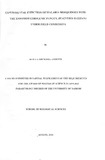| dc.description.abstract | Many successful laboratory studies have demonstrated the potential of using the entomopathogenic fungus, Beauveria bassiana against malaria mosquitoes. This study focussed on infection of wild malaria mosquitoes with the entomopathogeriic fungus B. bassiana under field conditions. Four experiments were carried out under laboratory conditions by use of World Health Organization bioassay cones, for exposure of3-6 days old, non-blood fed laboratory-reared Anopheles arabiensis mosquitoes on 100% black cotton cloths impregnated with spores of B. bassiana : from stocks of i) 80% viability for 10-70 minutes ii) 78, 51 and 50% including decayed spores of initially 80% viability iii) and 35% cotton cloths to determine virulence of fungus 3, 7, 14, 21, 28, 35 and 42 days post application.
Two field studies were carried out in three experimental huts located near the Ahero substation of the National Irrigation Board (NIB) (0008' S, 340 55' E), Kisumu County in Western Kenya to find out whether an increase in surface area of fungus-treated cloth panel led to an increase in fungus infection rates in wild malaria mosquitoes, and to determine efficacy of indoor wall spraying technique by use of B. bassiana formulated in oil, against wild malaria mosquitoes.
Results showed that 10 minutes were sufficient for B. bassiana to infect and kill An. arabiensis within 14 days. Further, results indicated that the risk of dying for mosquitoes was higher, 5.47 and 6.28 times when spores from stocks of 80 and 78%, respectively, were used, than when spores from stocks of 51 and 50% were used (Hazard Ratio 80%: HR=5.47 [95% CI: 3.13 - 9.54] Hazard Ratio 78%: HR=6.28 [95% CI: 3.66 - 10.79] Hazard Ratio 51%: HR=1.04 [95% CI: [0.62 - 0.62] Hazard Ratio 50%: HR=1.27 [95% CI: [0.76 - 2.12], respectively. Conidia were infective up to 28 and 7 days post impregnation on 100 and 35% cotton cloths respectively with an overall fungus infection of337 (60%) and 161 (40%), respectively. | en_US |

